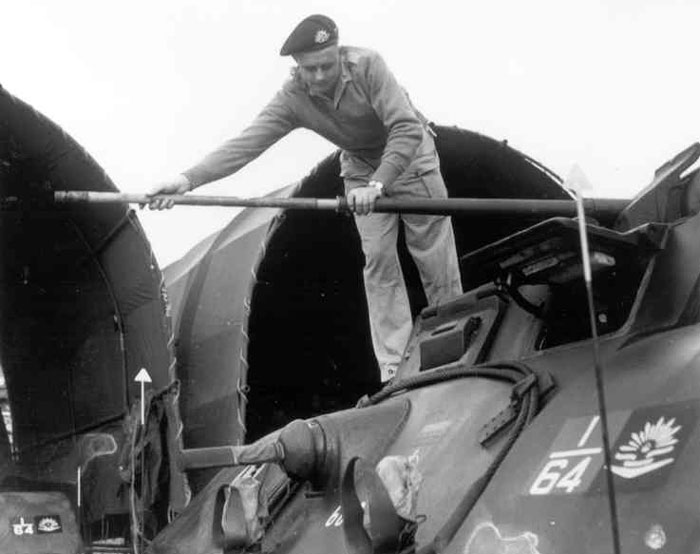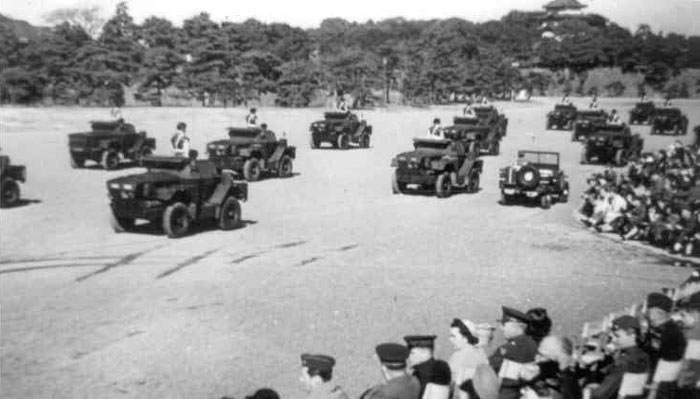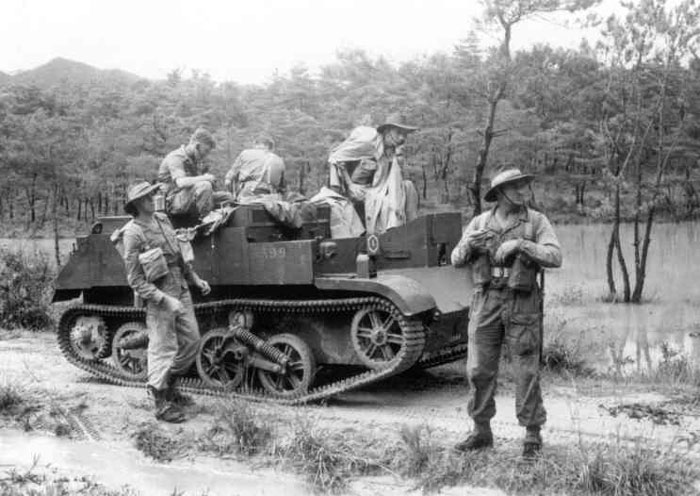![]()
Australian Armour in Japan 1946 to 1950
by Paul D. Handel
IntroductionFollowing the cessation of hostilities with Japan in August 1945, one of the highest priorities given by the Allies was to the occupation of the country to ensure the terms of the surrender would be kept and to assist in rebuilding the war – shattered infrastructure. Whilst a majority of the Occupation Force would be composed of US Forces, the nations of the British Commonwealth provided a composite force, known as the British Commonwealth Occupation Force (BCOF). This force included troops from the United Kingdom, India New Zealand and Australia. The first commander of BCOF was Lieutenant General John Northcott, an Australian who had been the first commander of the 1st Australian Armoured Division and later the Chief of the General Staff in Australia during the Second World War. The Australian Army component of the force was based upon the 34th Brigade Group, formed in late 1945 from volunteers of the about to be disbanded infantry battalions of the 2nd Australian Imperial Force (2nd AIF). Although armoured forces were considered not a vital component, an armoured car squadron was raised for service in BCOF. This was to be known as 1st Australian Armoured Car Squadron, and was formed from volunteers from the 4th Australian Armoured Brigade which had seen active service with Matilda tanks in New Guinea, Bougainville and Borneo. It was to be commanded by Major Cec Ives, a long serving armour officer who had originally arrived in Australia in 1937 from the Royal Tank Corps as a Sergeant to assist with the introduction into service of the then new Vickers Light Tanks Mark VIA. Ives was a strict disciplinarian which was to serve the Squadron well during its deployment in Japan.
Composition and EquipmentThe Squadron was raised at Puckapunyal, Victoria (the home of Australian Armour), in January 1946, and comprised 10 officers and 159 other ranks. Training began using the facilities of the Armoured School, and during February the Squadron received its armoured vehicles. 18 Staghound (T17E1) Armoured Cars and 8 Canadian Scout Cars Marks I/II (known in Australia as Golfballs or Doodlebugs) were drawn from the Ordnance Depot at Bandiana. It is believed these were vehicles from war reserve stocks, and had not previously been used. (As an aside, Australia received 279 Staghounds and 171 Canadian Scout Cars during the latter stages of the war.)
The Staghounds were basically standard as-built vehicles, excepting for an additional stowage box on the rear of the turret. These stowage boxes, fitted to nearly all Australian Staghounds after the Second World War, were the same as those mounted on the turret rear of the Australian Cruiser Tank Mark 1 (Sentinel). The Canadian Scout Cars were unmodified vehicles in as-manufactured form.
OperationsThe unit, together with the attached 348 Light Aid Detachment of the Australian Electrical and Mechanical Engineers (AEME), departed from Australia in late March 1946, arriving in the Bay of Hiroshima on 12 April. The unit disembarked at the port and moved by train to Kaitaichi, on the outskirts of Hiroshima, where a former Japanese ordnance depot was to be their home for three months. The armoured vehicles arrived by early June, and it was to their dismay that the troopers learned of the unsuitability of the Staghounds to their mobile role in that area of Japan. The roads were uniformly unsealed, and washed away in places. Many defiles provided natural obstacles, but the most serious was the weakness of all bridges to take the heavy (13 tons) Staghounds. By trial and error, it was found that the Staghounds were restricted to an area encompassing only the twin cities of Kure and Hiroshima. Late in June 1946, the Squadron provided a mounted escort for Lieutenant General Northcott, who was returning to Australia to assume the post of Governor of the state of New South Wales. His successor was none other than the second commander of the 1st Australian Armoured Division, Lieutenant General Horace Robertson (“Red Robbie”). A change of accommodation followed in July, when the unit moved to Hiro, about six miles on the opposite side of Kure, again in a former Japanese Army barracks. Duties during the following period included the cleaning up of the port of Onomichi of piles of debris, suppression of the black market trading in the area by searching shipping, and the discovery of a cache of Japanese military equipment, which had been secreted by Japanese officers and police during the period prior to the Occupation.
Reciprocal exchanges of personnel between units provided valuable cross training, and led to the unit’s only casualty. Patrolling the area between Kure and Hiroshima using the Staghounds was a frequent activity, and several crew positions in a patrol of these large armoured vehicles would be occupied by “outsiders”. On 31 October 1946, two Staghounds in a column of six vehicles overturned, instantly killing Private Little, a cook attached to the Squadron and so severely injuring Leading Aircraftsman (LAC) Edlund of the Royal Australian Air Force (RAAF) that he died during evacuation to the hospital. Seven other soldiers were injured. The vehicles overturned almost at the same time, although about one mile apart. The vehicles, when recovered, had suffered only superficial damage which was soon repaired. A military funeral was held for Private Little on 2 November, with his coffin being borne on the back of a Staghound Armoured Car. Later in the day, LAC Edlund was buried. Early in 1947, the unit was moved to Tokyo, where it was to share in the guard duties for the Imperial Palace. These were shared with the 66th Australian Infantry Battalion, which later became the 2nd Battalion Royal Australian Regiment, and was later to serve with distinction in Korea. Beacause of the unsuitability of the Staghounds for the Japanese road network, they were replaced by Canadian Scout Cars later in 1947. In November 1947, the Squadron, mounted in the Scout Cars, took part in a parade at the Imperial Palace grounds in Tokyo to celebrate the wedding of Princess Elizabeth (later HM Queen Elizabeth II) to Lieutenant Phillip Mountbatten, RN.
For summer exercises the Squadron found that there were satisfactory training areas on the island of Shikoku. The vehicles were moved there by landing craft. During one Brigade exercise, an actual operation was conducted against the large coal mine on the north side of the island. US sources advised their was a large cache of arms and ammunition hidden there, but when the Squadron surrounded the mine in a surprise dawn raid, the Brigade found the mine to be on fire and a search was impossible. The Squadron returned to Australia in December 1948, together with its remaining vehicles. In July 1949, the remaining members of the unit were formed into a new unit, the 1st Armoured Regiment, to become the first armoured unit of the new Australian Regular Army.
Other Australian Armour in JapanThe 34th Australian Brigade had three infantry battalions, which were generally based on those of the 2nd AIF, and had on their establishment Machine Gun Carriers. These were Australian designed and built LP2 and LP2A vehicles, differing from the British design in having an all-welded hull, and large stowage boxes on the rear.
These were extensively used during training in Japan, with the Battalions’ Medium Machine Gun Platoons and Mortar platoons each having a compliment to carry their weapons. The Assault Pioneer Platoons and the Battalions’ command element also had Carriers on strength. When the 3rd Battalion Royal Australian Regiment (3RAR) was deployed to Korea in 1950 to meet the North Korean invasion, their Carriers went to. But that is another story.
AcknowledgementsMany thanks to the RAAC Memorial and Army Tank Museum and to Barry Marriott for sharing the photos of Australian Carriers in Japan, and for the Scout Cars at the Imperial Palace. Barry has made extensive research into the use of Australian Pattern MG Carriers and I am grateful for his assistance and advice.
Australian Armour in Japan PHOTO ALBUMClick
the thumbnails in the table below to view the images full size.
Article Text and Photographs Copyright ©
2004 by Paul D.
Handel Back to Anzac Steel Main Page |









